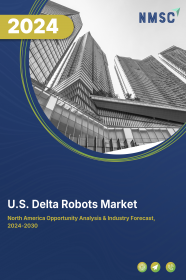
U.S. Delta Robots Market by Axis Type (Double Axis, Three Axis, Four Axis, Five Axis, and Six Axis), by Payload Capacity (Up to 3 Kilogram, 3.1 to 8 Kilogram, 8.1 to 15 Kilogram, and More than 15 Kilogram), by Version Environment (Standard and Hygiene), by Application (Assembly, Pick & Place, Material Handling, Palletizing/Packaging, and Others), by Industry Vertical (Electronics, Cosmetics, Food & Beverages, Pharmaceuticals, and Others) – Opportunity Analysis and Industry Forecast, 2023–2030
Industry: ICT & Media | Publish Date: 02-Dec-2024 | No of Pages: 75 | No. of Tables: 59 | No. of Figures: 28 | Format: PDF | Report Code : IC892
US Tariff Impact on U.S. Delta Robots Market
Trump Tariffs Are Reshaping Global Business
Market Definition
U.S. Delta Robots Market was valued at USD 187.84 million in 2022, and is predicted to reach USD 613.29 million by 2030, with a CAGR of 14.94% from 2023 to 2030. Delta robots, also known as parallel robots, represent specialized robotic systems distinguished by their distinctive mechanical design and exceptional precision. These robotic systems typically feature three or more arms connected to a shared base, forming a parallel mechanism that offers outstanding precision and structural stability. Delta robots have earned a reputation for their exceptional speed, agility, and accuracy, rendering them highly suitable for a diverse range of high-speed, precision applications across industries such as manufacturing, electronics, food & beverage, and pharmaceuticals.
The unique design of delta robots enables them to execute highly precise movements in all three dimensions, making them particularly well-suited for tasks found in assembly lines, pick-and-place operations, and intricate manufacturing processes. These applications often involve activities such as pick and place, assembly, packaging, and material handling.
Delta robots derive their superior performance from their parallel kinematic structure, a robotic system design in which multiple limbs operate in parallel to control the motion of the end-effector. This design affords precise coordination and control, resulting in remarkable rigidity and stability that ensures consistent and dependable performance. Depending on their specific configuration, delta robots can effectively handle a wide range of payloads, spanning from lightweight items to heavier components.
In summary, delta robots represent a class of robotic systems celebrated for their exceptional attributes of speed, precision, and versatility. Their unique parallel structure, characterized by rigidity, speed, and stability, positions them as the preferred choice for a multitude of high-speed automation tasks spanning various industries. Consequently, delta robots play a pivotal role in enhancing efficiency and precision in contemporary manufacturing and assembly processes.
Market Growth Fuelled by Active Product Launches from Key Players like ST Robotics
The presence of key market players, including ST Robotics, actively launching products for various end-users drives the delta robots market growth. For instance, in March 2021, ST Robotics unveiled the ST R18 Delta Robot System, the most recent inclusion in its affordable industrial robot lineup. This innovative Delta Robot was explicitly designed to meet the demands of swift pick-and-place operations in recycling plant conveyor systems.
The ST R18 Delta industrial robot turnkey solution draws inspiration from the Igus drylin delta robot but incorporates ST's K11R robot controller, enabling significantly increased speeds. It can complete a standard 12-inch cycle in a mere 500 milliseconds, and as a result, it is based on high-speed picking and placing on recycling plant conveyors.
Leading Pharmaceutical Companies Elevate Industry Efficiency and Quality with Delta Robots
Numerous prominent pharmaceutical companies, including Abbott Laboratories, Johnson & Johnson, Pfizer Inc., and Merck & Co., have harnessed the capabilities of delta robots in their precision-driven pharmaceutical manufacturing and packaging operations. This strategic adoption has led to substantial advancements in the pharmaceutical industry, marked by enhanced operational efficiency and the consistent delivery of high-quality products.
Delta robots' precision and reliability have played a pivotal role in ensuring the accuracy and reliability of critical processes, ultimately contributing to the industry's reputation for producing safe and effective medications. Thus, creating significant growth of the market.
The High Cost of Delta Robots Hinders Market Growth in U.S.
The high cost of delta robots presents a substantial restraint on the market's growth. These robots, known for their precision and efficiency, often come with a price tag that can be a barrier to adoption for many businesses, particularly small and medium-sized enterprises (SMEs).
Additionally, the extended return on investment (ROI) period due to high upfront costs can deter companies seeking more immediate cost savings and efficiency improvements. This situation hinders market growth and contributes to market concentration, with only larger corporations able to afford and benefit from this advanced automation technology.
Integration of Advanced Technologies to Enhance Precision represents a significant opportunity for the Market
Integrating advanced technologies, such as computer vision and artificial intelligence (AI), to enhance precision represents a significant opportunity for the delta robot market. These cutting-edge technologies enable delta robots to operate more accurately and efficiently, opening up new avenues for applications across various industries.
The integration of computer vision and AI not only enhances precision but also improves overall productivity and reduces errors in manufacturing processes. This can result in cost savings, higher product quality, and increased competitiveness for businesses that leverage delta robots with these advanced technologies. As industries continue to embrace automation and demand higher precision and flexibility, the delta robot market is poised to benefit significantly from the opportunities created by integrating computer vision and AI.
Competitive Landscape
The U.S. Delta Robots industry includes several market players such as ABB Ltd., Fanuc Corporation, Kawasaki Heavy Industries Ltd, Yaskawa Electric Corporation, FESTO, Weiss GmbH, Omron Corporation, IGUS GmbH, Cama Group, and KUKA AG.
Key Benefits
-
The U.S. Delta Robots market report provides a quantitative analysis of the current market and estimations through 2023-2030 that assists in identifying the prevailing market opportunities to capitalize on.
-
The study comprises a deep dive analysis of the market trend including the current and future trends for depicting the prevalent investment pockets in the market.
-
The information related to key drivers, restraints, and opportunities and their impact on the market is provided in the report.
-
The competitive analysis of the market players along with their market share in the U.S. Delta Robots market.
-
The SWOT analysis and Porter’s Five Forces model are elaborated in the study.
-
Value chain analysis in the market study provides a clear picture of the stakeholders’ roles.
U.S. Delta Robots Market Key Segments
By Axis Type
-
Double Axis
-
Three Axis
-
Four Axis
-
Five Axis
-
Six Axis
By Payload Capacity
-
Upto 3 Kilogram
-
3.1 to 8 Kilogram
-
8.1 to 15 Kilogram
-
More than 15 Kilogram
By Version Environment
-
Standard
-
Hygiene
By Application
-
Assembly
-
Pick & Place
-
Material handling
-
Palletizing/ Packaging
-
Primary
-
Secondary
-
-
Others
By Industry Vertical
-
Electronics
-
Cosmetics
-
Food & Beverages
-
Pharmaceuticals
-
Others
REPORT SCOPE AND SEGMENTATION:
|
Parameters |
Details |
|
Market Size in 2022 |
USD 187.84 Million |
|
Market Volume in 2022 |
9764 Units |
|
Revenue Forecast in 2030 |
USD 613.29 Million |
|
Growth Rate |
CAGR of 14.94% from 2023 to 2030 |
|
Analysis Period |
2022–2030 |
|
Base Year Considered |
2022 |
|
Forecast Period |
2023–2030 |
|
Market Size Estimation |
Million (USD) |
|
Growth Factors |
Active participation of leading pharmaceutical firms. Existence of significant market players |
|
Companies Profiled |
10 |
|
Market Share |
Available for 10 companies |
|
Customization Scope |
Free customization (equivalent up to 80 working hours of analysts) after purchase. Addition or alteration to country, regional, and segment scope. |
|
Pricing and Purchase Options |
Avail customized purchase options to meet your exact research needs. |
Key Players
-
ABB Ltd.
-
Fanuc Corporation
-
Kawasaki Heavy Industries Ltd.
-
Yaskawa Electric Corporation
-
FESTO
-
Weiss GmbH
-
Omron Corporation
-
IGUS GmbH
-
Cama Group
-
KUKA AG

















 Speak to Our Analyst
Speak to Our Analyst





















